4 March 2013
- Kayak trip on the Khwae Noi River in Central Thailand (Kanchanaburi area) from Wang Krachae until Ban Kao as part of the Khwae Noi River Kayak Route.
- Technical data:
- We started off at the Phung Waan Resort at 0750 Hr. There was a good current estimated at 5 Km/Hr. There were no obstructions on the river, with the exception of a rapid just after leaving the resort. We arrived at the Botanic Garden Park Resort in Ban Kao around 1705 Hr.
- The weather was overcast. Max. Temperature was 29 C and we got very strong head wind blowing from the southeast.
- Technical data of the trip was as follows: Total Distance: 72.8 Km; Moving Average: 8.5 Km/Hr; Overall Average: 7.8 Km/Hr; Maximum Speed: 12.9 Km/Hr; Moving time: 8 Hr 35 Min; Stopped Time: 44 Min; Total Time: 9 Hr 19 Min. We made no lunch stop along this track.
- Number of participants: 2 (Pat & Sean)
We woke up after a good night’s rest, the beds and rooms of the resort were the most comfortable of the trip and we went to breakfast at 06h00 feeling refreshed and ready for an early start as today was the day we faced the longest leg, 70 Km in all, due to us finishing 5 Km short the day before. The morning was overcast and cool, and we hoped that the conditions would continue to give us some assistance for the long day ahead.
We could not launch our kayaks at the spot we had landed the previous day as the current was too strong, thus we needed to transport the boats a few hundred meters to the south where the resort had some anchored bamboo rafts, it would have saved us a lot of trouble if we had known about this location the day before! The resort provided us with a Tuk-Tuk to assist in transporting our kayaks from the pavilion to the new launch location, however before that, Sean had to make a trip with the driver to reception to buy extra bottles of water for the trip, which he had forgotten to buy at breakfast. On his return we moved the kayaks one by one to the planned launch area. While we were kitting up, the driver explained to us that just around the bend there was a section of rapids with some big rocks that we should be prepared for; the long tail boats usually negotiated them by driving up the middle of the river.
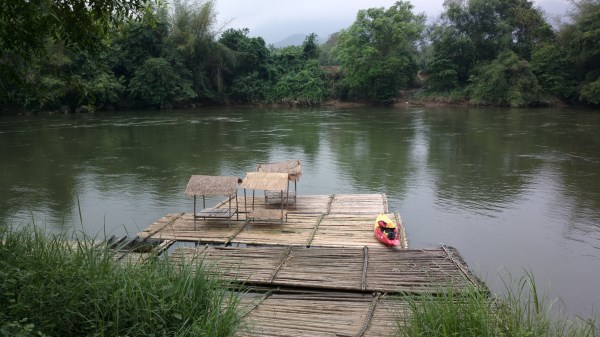
Bearing this in mind we set off just before 08h00 and indeed, as we rounded the bend the rapids were visible with rocks near to the right bank; any sleep residue that remained was rapidly flushed away by the adrenalin as we prepared for the task at hand. The rocks the driver had mentioned were there, but there was also a lot of hidden rock on the opposite side which were causing big boils of turbulent water; we were forced to pass close by these as we hugged the left bank, but we managed to pass without incident, now fully awake!

Twenty minutes later we rounded another corner and suddenly found ourselves upon a shallow pebble bed, Sean felt his kayak catch on the bottom and momentarily thought he would swing sideways and overturn, however he came free and glided away as the pebbles passed inches underneath in the clear, strong flowing water. We suspected that the pebble bed was in fact a ford that allows access to the River Kwai Golf & Country Club when the river was low, as concrete ramps were visible on each side of the river banks. We were now at the location where we had initially thought the Phung Waan Resort was located, a bit downstream from the golf course, based on information sourced online which had now proved to be inaccurate. We had burned up our 5 Km deficit with the good flow and were finally where we could start the planned tracks for the day.
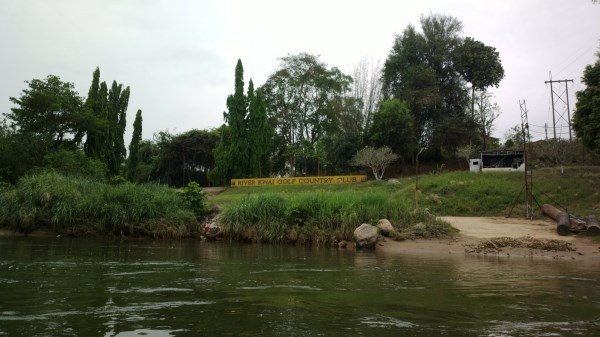
We continued downstream winding through a beautiful landscape of rocks and green jungle devoid of any human activity along the river banks, making good progress with the overcast conditions and good flow. After an hour we came to a bend and heard the hypnotic sound of monks chanting and as we floated on, the first buildings of Wat Khae, a large temple complex, came into view and soon the entire complex was visible. Also in view high on the hills above us was the shape of Wat Tham Khao Noi's, a Chinese-style pagoda, towering over the landscape. As we drifted under the suspension bridge linking the temple to the opposite bank the chanting faded and with it, even though we did not know it yet, the end of the ‘easy’ part of our trip.
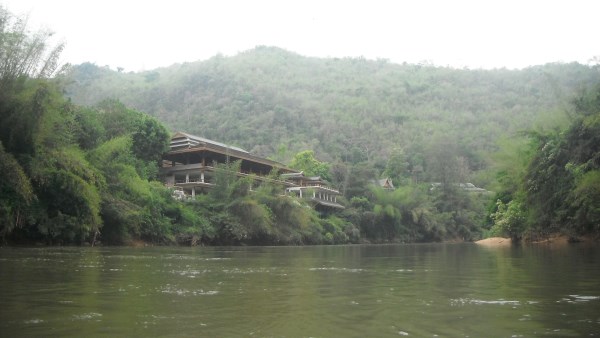
We were now moving into the area where the original Death Railway ran and as we turned each bend, we strained to see any signs of the railway through the dense jungle. The Death Railway was a strategic railway built between Thailand and Burma during WWII. The Japanese High Command was forced to accept after the Battle of Midway in June 1942, that naval superiority in the pacific had become unattainable. This realization led directly to the birth of the Thailand-Burma railway as a vital alternative to supply the Japanese Army in Burma. The railway line, 415 kilometers long, followed the same route the British had surveyed in 1903: the line from Nong Pladuk passing through Kanchanaburi and crossing the Khwae Yai River to follow the Khwae Noi to the Burmese border. From the Three Pagoda Pass it travelled northwest to link up with the British line to Rangoon at Thanbyuzayat on the Burmese coast.
On one bend we looked up but saw only a vague line, which we presumed must be the track. We paddled further, took a new bend and saw the railway just above us. A signal pole and a wooden bridge of the track cut out in the rocks were clearly visible. The first survey by the Japanese engineers estimated that it would take at least five years to finish this railway line, but the Japanese army forced prisoners to complete it in only sixteen months. Construction began on 16 September 1942 at Nong Pladuk and the railway was completed on 25 December 1943; an incredible effort paid with blood, tears and many lives.
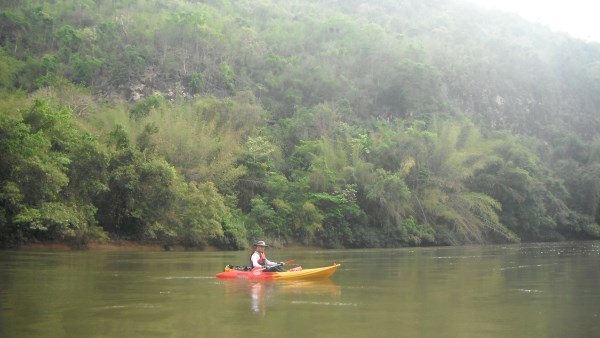
As we continued on the clouds burned away, the sun came out and it got hot, the hottest we had yet felt on the trip. We also started to notice our speed dropping hourly and this was borne out by the watermark on the sand banks which indicated that the water had dropped about 40-50 cm. For some reason we were losing the assistance of the river flow, it was going to be a long day.
Shortly after 10h00 we passed the floating rafts of Sai Yok Place and ten minutes later some form of elephant village where Thai mahouts and tourists were bathing and playing with the large animals in the river.
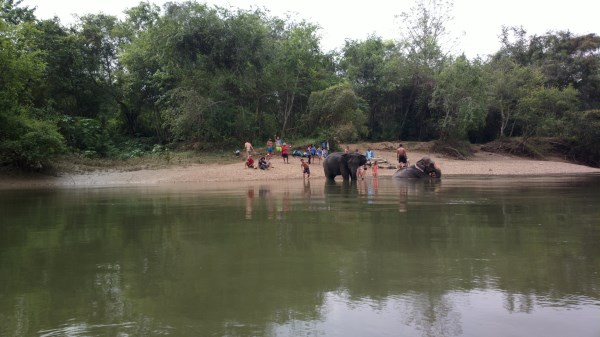
We continued paddling, passing the Yoko Resort rafts to reach our highlight of the day; and possibly the whole trip, Tham Krasae and the Wang Po tiered viaduct, the iconic symbol of the railway and its history, a long trestle bridge built along the edge of the river in March-April 1943 and still operational.

We beached on a pebble bank on the river bend opposite the Krasae Cave and the railway station, and at the beginning of the wooden Wang Po viaduct. People walking on the viaduct near the cave were waving to us and taking photographs, we had become part of the tourist attraction. The black hole of the cave was easily distinguishable, it was used as an air raid shelter by the Japanese and also as a refuge for many sick Asian laborers some of whom perished therein; today there is a Buddha image set up in the cave and often a monk resides there. As he stood there, Patrick though back to the many times he had visited it before and never dreamt that one day he would be standing below on the bend in the river looking up at the cave. After taking in the view and snapping some photographs, we pushed off our kayaks and continued the trip. The sightseeing was over, it was 11h00 and we still had just under 50 Km to go.
As we headed down the next section of river the wind started to pick up, blowing hard from the south-southeast right into our faces. Sean was momentarily taken by surprise and his hat was blown clean off his head into the river behind. He turned to retrieve it, came alongside and managed to hook it with his paddle, but it slipped off. He turned again only to see it rapidly sinking below the surface as it soaked up the water and before he could get to it, it had slipped below the now dark and muddied waters, to become an offering to whatever lived below. The curse of the Wang Po viaduct!

We carried on and at 12h45, near the bridge of Ban Yang Thong marking the end of the fifth track, we stopped on the left bank to stretch and replenish the energy with snacks and energy drinks. Without a hat, Sean now faced the prospect of paddling the next 40 Km, and a good 4-5 hours with his fine facial features fully exposed to the afternoon sun, a prospect he did not relish. As he did not have a spare hat (now added as a requirement for future trips!) he had to improvise and ended up using his lycra vest from the previous day to wrap around his head, allowing only a small gap through which to see and breathe, it was not the most comfortable, but it would serve its purpose.

With Sean now looking like something from a Touareg, we set off again at 1300 Hr. We passed the bridge and saw an elephant village located on the right bank, the weather was again overcast but now hot and humid with wind a constant nuisance. As Sean paddled he started to feel a pain in the region of his left elbow, some sort of repetitive injury strain. He tried to adjust his paddle motion; it helped somewhat but with each stroke the pain still bit. We were also now encountering new terrain, the spectacular natural scenery and historical sites were a thing of the past and we were now entering an area of little visual stimulation. Sean looked at him map and it was devoid of any waypoints but still showed that we had 35 km to complete, the vest on his head was now also uncomfortable and hot, it was not a good situation. He had to find some way to mentally get through the next few hours. Looking at the map between his feet he found the answer; the next 12 Km of the river had some noticeable shapes, one looked like the outline of a koala bear while the other was that of the profile of a kangaroo, we just had to negotiate these then it was only 20 Km to go and all ‘downhill’. He set off and to conquer these features one section at a time, ‘up the back’, ‘over the ear’ ‘across the head’… Behind him he heard Patrick’s paddle strokes close by, he could not let up the effort an let him pass, to do so and fall behind could mentally break him and he did not know if he would then be able to keep up, so he pushed on hard despite the pain and discomfort. Little did he know that Patrick was in the same ‘boat’, he had found out that by keeping close to the stern of Sean’s boat he was able to slipstream and save vital energy. And so we went Km after Km, one pushing and the other pulling, driving each other to the destination; no conversation, no photographs. I don’t think one would have been able to do it alone. Eventually we had navigated the Australasian marsupials and we ‘only’ had about 20 Km to go. We normally measured kayak distances in terms of the distance it took to row around the Ayutthaya Island, the distance left equated to about two times round – a piece of cake!

We closed on the ancient city of Mueang Sing, located on our left hand side. The south wall wound along the Khwae Noi River, while there was an embankment of earth on each of the inner sides of the wall. The city, dating to the 12th and 13th centuries, was square shaped, surrounded by moats, ramparts and laterite walls. The 5 meters high wall around the city was 1400 m long by 880 m wide with gates on the four sides. We left the ancient city behind us and from time to time encountered a resort. It became more and more clear that we had entered the plains, the water changed from crystal clear into brown and brackish, most likely due to farm drainage runoff. After the bridge near the Banana Resort in between Sing and Ban Kao we marked the 60 kilometers in a day milestone. Our previous longest distance covered was just over 50 kilometers when we paddled the first track of the Chao Phraya River, from Nakhon Sawan to Uthai Thani in July in 2012. We were soon closing in on the 70 Km mark, the mental and physical barriers had been broken as we strove toward the target, just west of our destination we came across a long curving bend with signs of major soil erosion, an indication that at some time the river did get a lot higher in this section. We then had to contend with a long straight section of river, with strong headwind and waves, leading up to the bridge at Ban Kao, it was on this section that we passed the magical 70 Km in a day barrier.
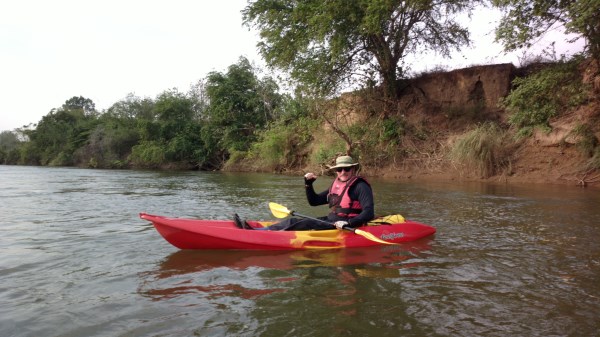
We pushed on and just before 17h00 arrived in the Ban Kao area which had got its name from the discovery of Stone Age tools; in addition there was a Neolithic burial site by a Dutch POW located there. The findings revealed that Ban Kao was once a dwelling of prehistoric men. Moving on past Ban Kao we started to look out for our destination, the River Kwai Botanic Garden Resort, mindful of what had happened the day before. This time however we were prepared as the night before we had studied the hotel website and had a good idea what it looked like viewed from the river. We eventually saw it and put a plan of action in place; over the last two days we had practiced coming alongside floating hotels to practice the technique which was: pass close by the raft, make a 180 degree turn and then paddle alongside the raft against the current. As soon you have spotted a place where you can climb onto the raft, hold on to it and quickly tie up the kayak. After that one had to concentrate on the delicate move of climbing aboard, without getting sucked under the raft. We determined that this would work in flows up to 7 Km/hr but anything more than that it would not be possible to paddle back up.

We saw that there was a floating platform located alongside the main row of floating rooms, we decided to head behind it to get some protection, then turn against the current and try to find a landing spot. As we passed the platform we could see no ladders or ways to get out, something we had come to expect! Sean turned first and came alongside the balcony of the room closest to the platform and quickly tied off. He then had to lift himself on to the balcony; the only way was via an ornate wooden railing that looked anything but stable, however it managed to hold him and he then stretched across, Spiderman style, to get aboard the floating platform and then pulled his kayak to safety. It was now Patrick's turn, he managed to exit his kayak and traverse the obstacles without a problem, we soon had his kayak also safely on board, we were getting the hang of this!
We de-rigged our kayaks and kit and went up to the reception; apparently nobody saw us arriving. When we checked in we found out that, with the exception of one family, the resort was empty. We were also the only two people on the house rafts and funny enough the house raft we boarded on our arrival became our rooms.
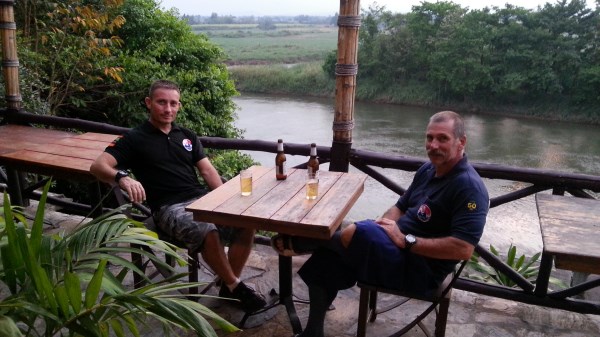
We got our keys, and went back to the rooms and scouted how to get in the water the next morning, the plan was the same as the second day; launch behind the rafts where the flow was weakest. Having resolved that we adjourned to our rooms for an hour to sort out our things and recuperate. Sean was broken and decided get a quick nap in before dinner to refresh, Patrick decided to catch up on the latest Thai Soap opera on TV which permeated the thin rattan walls. About an hour later, under slept and soap opera satiated, we met on the balcony to sit and watch the sun setting over the river. We then headed up to the restaurant and ordered a beer and food. The food was not that good and, after the exertion of the day, Sean did not have an appetite, ending up feeding most of his food to the two cats circling the table. It was then that he realized that he needed to buy a hat for the next day. We asked the staff and they said that there was a store selling hats about 400 meters up the road from the resort, we initially thought of walking but then one of the staff offered to drive him there. This was a good thing as the shop ended up being quite a distance away located in the centre of the town of Ban Kao! The selection was not great, it was either a colorful effeminate hat or a straw farmer’s hat, he bought the latter for Baht 45 and they then drove back to the hotel.
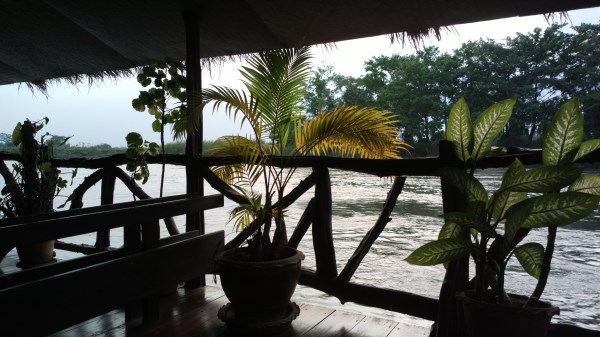
We had a final beer on the terrace then adjourned to our rooms, stiff but happy with the days accomplishment and ready for some welcome sleep. The next day was the final leg, an ‘easy’ 50 km trip to Kanchanaburi; however, as they say “the last legs and as always the last mile is the longest”.